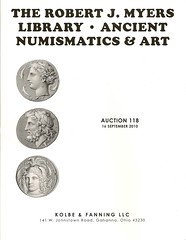
PREV ARTICLE
NEXT ARTICLE
FULL ISSUE
PREV FULL ISSUE
KOLBE & FANNING SALE 117/118 CATALOGS AVAILABLETwo catalogs arrived in the mail this week, and by now many of our readers should have their copies as well - the 117th and 118th sales of Kolbe & Fanning.


Below are some excerpts from sale #118, an essay titled "A Numismatic Life" by the consignor, Robert J. Myers.
My career as a numismatist had an unlikely beginning in an atypical setting. One day, at the age of 13, while living with my folks in Grand Rapids, Michigan, I visited an elderly widower. He had a box of old coins and eagerly sat with me relating their stories. On that day I bought my first ancient coin, a bronze of Augustus, and paid less than a dollar for it. To put things into perspective, at that time bus rides were a nickel. With that coin of Augustus I was hooked, found a Grand Rapids coin club and joined immediately. Fast forward through marriage and fatherhood, which left neither time nor money for academic pursuits. Still, though I couldn't afford the best, I continued buying coins – mostly ancient and a few foreign. I returned to college later in life with two children to support, not much money and lots of coins. To support ourselves, another student and I opened a stamp (his specialty) and coin shop. It was my good fortune to be the only person in a 100 mile radius to be offering ancient and foreign coins. I also started buying books on the field and left Indiana University with more books on ancient coins than on biochemistry, which was my specialty. Because of my expertise in bio-lab work (and the fact that they had a newly acquired, very expensive electron microscope no one on staff knew how to use) Cornell Medical College brought me to New York, where I did medical research until the mid 1970s when the projects' grants ran out. Cornell then hired me into hospital administration, which did not suit the scientist in me and I left. When I first moved to New York I'd met Aaron Feldman. We became friends and I followed, almost religiously, his axiom, “Buy the Book before the Coin”. Thus, all during my hospital stint, I'd been building bookshelves in my railroad flat apartment and adding to my library. The sources, mostly European and American auctions and dealers, were international. In this period I began utilizing (and purchasing from) the fine catalogues and auctions of George Frederick Kolbe. I now had the library (thanks, Aaron), a few coins and a great interest in antiquities so began buying and selling both. Thus I followed the adage that one should find something one loves and figure out how to make a living from it. I was then officially in the ancient coin and antiquities business. Timing was perfect. The business was flourishing. Since I had the genesis of a good library, I started cataloging for other clients then decided to hold my own auctions. It never occurred to me to hire an auctioneer (probably a throw-back to the off-Broadway acting I did while at the hospital) so I obtained an auctioneer's license. As an aside, that license opened another aspect of my career as I was later hired as auctioneer for several American and European firms. Calling auctions in three languages in Switzerland was quite the challenge.
For more information, see:
www.numislit.com
The Numismatic Bibliomania Society is a non-profit organization promoting numismatic literature. See our web site at coinbooks.org. To submit items for publication in The E-Sylum, write to the Editor at this address: whomren@gmail.com To subscribe go to: https://my.binhost.com/lists/listinfo/esylum All Rights Reserved. NBS Home Page Contact the NBS webmaster 
|